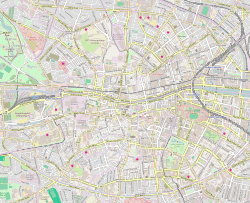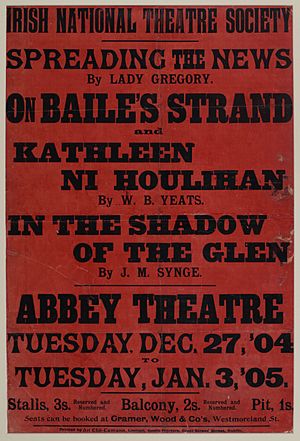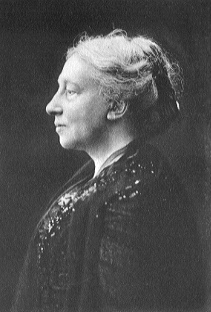Abbey Theatre facts for kids
|
Ireland's National Theatre
|
|
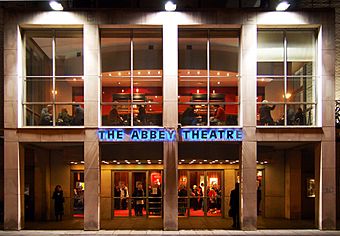
Front façade
|
|
| Address | 26 Lower Abbey Street Dublin Ireland |
|---|---|
| Coordinates | 53°20′54″N 6°15′26″W / 53.348333°N 6.257222°W |
| Owner | Abbey Theatre Limited (prev. National Theatre Society) |
| Designation | National Theatre of Ireland |
| Capacity | 492 |
| Construction | |
| Opened | 1904 |
| Rebuilt | 1966 |
| Architect | Joseph Holloway (1904) Michael Scott (1966) |
The Abbey Theatre (Irish: Amharclann na Mainistreach), also known as the National Theatre of Ireland (Irish: Amharclann Náisiúnta na hÉireann), is a famous theatre in Dublin, Ireland. It is one of Ireland's most important cultural places. It first opened its doors on December 27, 1904. After a fire in 1951, it moved from its first building. The Abbey Theatre has been active ever since.
It was the first theatre in the English-speaking world to get money from the government. From 1925, it received yearly support from the Irish Free State. Since July 1966, the Abbey has been at 26 Lower Abbey Street, Dublin 1.
In its early days, the theatre worked closely with writers from the Irish Literary Revival. Many of these writers helped start the theatre. Most of their plays were performed there. The Abbey helped many great Irish playwrights become famous. These included William Butler Yeats, Lady Gregory, Seán O'Casey, and John Millington Synge. It also helped many leading actors. The Abbey Theatre has also toured a lot overseas. This has made it an important part of Irish culture around the world.
Contents
History of the Abbey Theatre
How the Theatre Started
The Abbey Theatre came from three main ideas. The first was the Irish Literary Theatre. Lady Gregory, Edward Martyn, and W. B. Yeats started it in 1899. They got help from George Moore. This group put on plays in other Dublin theatres. Critics liked the plays, but not many people came to see them. Lady Gregory wanted to create Irish plays that mixed Irish culture with European theatre styles.
The second idea came from two Dublin directors, William and Frank Fay. The Fay brothers put on plays in halls around Dublin. They formed a group called the W. G. Fay's Irish National Dramatic Company. Their goal was to help Irish actors get better. In April 1902, the Fays performed two plays. These were Deirdre by Æ and Cathleen Ní Houlihan by Yeats. These shows were a big success. Many working-class people came to watch.
The third idea was the money and experience of Annie Horniman. She was an Englishwoman who loved theatre. She came to Dublin in 1903 to help Yeats. Her money helped start the Abbey Theatre.
The creation of the Abbey Theatre was also part of a bigger change in European theatre. New theatres were opening that challenged old ways of performing. Lady Gregory wanted the Abbey to be a theatre for everyone.
Building the Theatre
After their success, Yeats, Lady Gregory, Æ, Martyn, and John Millington Synge started the Irish National Theatre Society in 1903. Annie Horniman provided the money. Actors and playwrights from the Fay brothers' group joined them. At first, they performed in a hall. Then, a theatre building on Lower Abbey Street became available. It was closed because of fire safety issues. Horniman and William Fay decided to buy and fix up the building for the society.
On May 11, 1904, the Society officially accepted Horniman's offer. Horniman paid for the theatre. The founders chose William Fay to manage the theatre. He was in charge of training the actors. Yeats' brother Jack painted pictures of the theatre's main people for the lobby.
The Abbey Theatre opened on December 27, 1904. The first night featured three short plays. These were On Baile's Strand and Cathleen Ní Houlihan by Yeats, and Spreading the News by Lady Gregory. Frank Fay was the first actor on the Abbey stage. He played Cúchulainn.
In 1905, Yeats, Lady Gregory, and Synge decided to make the theatre a company. This upset Horniman. She started a new theatre company in Manchester. Many leading actors left the Abbey at this time.
The press was impressed with the new building. The Cork Constitution newspaper wrote that the theatre had "neither orchestra nor bar." They also noted that the main entrance was through a building that used to be a morgue. This surprised many theatregoers.
Key People Who Helped
Lady Gregory
Lady Gregory helped create the Irish Literary Theatre. She met Yeats in 1898. They both dreamed of creating a theatre for new Irish plays. Lady Gregory was very important in finding money for the theatre. She also gave some of her own money.
She wrote many plays for the Abbey. She was especially good at writing short, one-act plays.
William Butler Yeats
The Abbey Theatre is sometimes called Yeats' theatre. He wanted a theatre where the writer's words were the most important thing. He believed authors should have control. He, Lady Gregory, and Synge became the theatre's directors.
Yeats worked closely with Lady Gregory. He also had a very important relationship with Annie Horniman. She helped fund his projects. He became the president of the Abbey Theatre in 1904.
Annie Horniman
Annie Horniman was a British theatre lover. She was very important in starting the Abbey Theatre. She was its first big supporter. She offered the building where the theatre was set up. Yeats first brought her in to design costumes for one of his plays.
Horniman came from a rich family. She gave a lot of money to the Abbey. In 1903, she offered to give Yeats a theatre in Dublin. It was worth a lot of money. She had strict rules for this deal. Most importantly, she said there should be no politics in the theatre. She did not like Irish politics, especially nationalism. This caused arguments with her colleagues. She also made tickets more expensive. This made the Abbey one of the most costly theatres in Dublin.
She stayed involved for a few difficult years. She left in 1907. She felt she couldn't express herself at the Abbey. She stopped giving money in 1910.
Early Years and Challenges
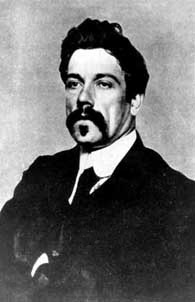
In the early years, it was hard to find plays by Irish writers. So, the founders set rules for writers. They also wrote some plays themselves. The Abbey Theatre became very popular. Many people came to its shows.
The Abbey was lucky to have Synge. He was considered one of the best English-language playwrights. The theatre performed many plays by famous writers. These included Yeats, Lady Gregory, Padraic Colum, George Bernard Shaw, and Lennox Robinson. Many of these writers were on the theatre's board. This is when the Abbey became known as a "writers' theatre."
However, things got worse in January 1907. Synge's play The Playboy of the Western World caused riots. Some nationalists thought the theatre was not political enough. Many people in the audience rioted loudly. The actors had to finish the play without speaking. The theatre called the police, which made the nationalists even angrier. The protests eventually stopped. But the Abbey's leaders were shaken. They decided not to perform Synge's next play.
In 1908, the Fay brothers left the theatre. They moved to the United States. Lennox Robinson took over managing the Abbey. Annie Horniman also stopped giving money.
In 1909, Shaw's play The Shewing-Up of Blanco Posnet caused more protests. That same year, the theatre decided to become independent from Annie Horniman. Their relationship had been difficult. Horniman wanted to choose which plays were performed. In May 1910, Dublin theatres were supposed to close to respect the death of King Edward VII. Robinson kept the Abbey open. When Horniman heard this, she ended her connection with the company. She had invested a lot of money in the theatre.
With Horniman, Synge, and the Fays gone, the Abbey struggled. Fewer people came to shows. This changed when Seán O'Casey became a new playwright. O'Casey's first play, The Shadow of a Gunman, was performed in 1923. Then came Juno and the Paycock in 1924, and The Plough and the Stars in 1926. The last play also caused riots, like Playboy did years before. The Abbey rejected O'Casey's next play. He then moved to London.
World War I and the Irish Rebellion of 1916 almost closed the theatre. But in 1924, Yeats and Lady Gregory offered the Abbey to the Irish government. The government refused. However, the next year, the Minister of Finance, Ernest Blythe, arranged for the Abbey to get £850 each year from the government. This made it the first state-supported theatre in the English-speaking world. This money saved the theatre from going bankrupt.
Other Schools and Theatres
The Abbey School of Acting was set up around this time. The Abbey School of Ballet was also started by Ninette de Valois. It ran until 1933.
The company also got more space. This allowed them to create a small experimental theatre called the Peacock. In 1928, Hilton Edwards and Micheál MacLiammoir started the Gate Theatre Studio. They used the Peacock to perform plays by European and American writers. The Gate also looked for new Irish playwrights. It moved to its own building in 1930.
From the 1930s to the 1950s
The Abbey continued to be a writers' theatre even after Yeats became less involved. Frank O'Connor was on the board from 1935 to 1939. He also managed the theatre for a time. In 1941, Ernest Blythe, a politician, became the managing director.
During the 1940s and 1950s, fewer new plays were produced. But more people came to the theatre. The Abbey was no longer just for the rich or a small group of thinkers. It had become a theatre for everyone. Plays by O'Casey and Lennox Robinson helped with this change. The theatre also changed how long plays ran. Instead of just one week, popular plays now ran until fewer people came to see them.
During these years, the Abbey often showed funny plays about an old-fashioned Irish country life. This kind of play was no longer popular with most Irish people. So, audience numbers kept going down. But popular actors like F. J. McCormick and writers like George Shiels still brought in crowds.
From the 1950s to the 1990s
On July 17, 1951, a fire damaged the Abbey Theatre. Only the Peacock theatre was left untouched. The company then used the old Queen's Theatre until 1966.
The board planned to rebuild the theatre. The Irish architect Michael Scott designed the new building. On September 3, 1963, the President of Ireland, Éamon de Valera, laid the first stone for the new theatre. The Abbey reopened on July 18, 1966. The new building cost more than expected.
A new building and new playwrights helped the theatre. Writers like Hugh Leonard, Brian Friel, and Tom Murphy became famous. Tourism also helped, as the National Theatre was a key attraction. The theatre's involvement in the Dublin Theatre Festival from 1957 also helped. Plays like Brian Friel's Philadelphia Here I Come! (1964) and Dancing at Lughnasa (1990) became very popular. They were performed in London and New York. This helped the Abbey become known around the world.
Challenges in the 2000s
In December 2004, the theatre celebrated its 100th birthday. They put on special shows, including the original opening night plays. But things were not going well. Fewer people were coming to shows. The Peacock theatre was closed because of a lack of money. The theatre was almost bankrupt. Staff members worried about losing their jobs.
In September 2004, two playwrights on the theatre's council criticized the Artistic Director, Ben Barnes. They said he was touring in Australia while the theatre had big money problems. Barnes later resigned in May 2005. The new director, Fiach Mac Conghail, took over that same month.
Rebuilding the Abbey
On August 20, 2005, a plan was approved to change how the Abbey Theatre was owned. The Arts Council of Ireland then gave the Abbey a large grant of money. This was the biggest grant ever given by the Arts Council. A new company was set up on February 1, 2006.
In 2009, the theatre started a new program for playwrights. More than 30 writers were asked to write plays for the Abbey. The Abbey also worked with the Public Theater in New York. They performed two new plays there. The Abbey also made history in 2009/10. They performed four new plays in a row by women writers.
The Abbey also had a special program called Waking the Nation. This was to remember the Easter Rising of 1916. There was some discussion because only one of the ten plays was by a female writer.
New Leaders and Building Plans
In 2016, two new co-directors took over the Abbey. Neil Murray and Graham McLaren wanted to tour more. They also wanted to show a wider range of plays. They also worked on plans to rebuild the theatre. McLaren described the current building as "the worst theatre building I have ever worked in."
After looking at other locations, they decided to rebuild the Abbey in its current spot. The Abbey Theatre bought nearby buildings in 2012 and 2016. The plan is to remove the old building and build a new one. It will have two new theatre spaces, a restaurant, and new offices. The new theatre will open onto the Liffey quays. As of January 2020, construction had not yet started.
In February 2021, two new co-directors were chosen. Caitriona McLaughlin became the Artistic Director. Mark O'Brien became the Executive Director.
See also
 In Spanish: Abbey Theatre para niños
In Spanish: Abbey Theatre para niños


